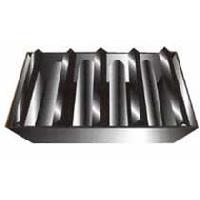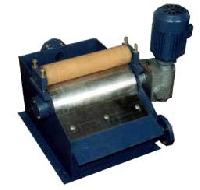






Eddy Current Separator
Get Price Quote
JAYKRISHNA Have developed Eddy current separators are commonly used to separatenon-ferrous metals from mixed waste and other product streams. When a magnetic rotor is turned at high rates of speed, powerful forces called eddy currents are created. These eddy currents repel materials with varying degrees of force depending on their composition. Thus, aluminum, copper and other metals can be separated from glass, plastic, wood, etc. creating clean product. The principle of the Eddy Current Separator is fairly straightforward. Basically, a rotor comprised of magnet blocks, either standard ferrite ceramic or the more powerful rare earth magnets depending on application, are spun at high revolutions (over 3000 rpm) to produce an ‘eddy current’. This eddy current reacts with different metals, according to their specific mass and resistivity, creating a repelling force on the charged particle. If a metal is light, yet conductive such as aluminum, it is easily levitated and ejected from the normal flow of the product stream making separation possible. Separation of stainless steel is also possible depending on the grade of material. Particles from material flows can be sorted down to a minimum size of 3/32" (2mm) in diameter. There is no question that Eddy Current Separators have been a crucial development for the recycling industry. In a world of depleting natural resources the race is on to find faster, cheaper, more efficient ways of reclaiming and recovering raw materials, as well as improving the purity and reducing the risk of contamination during their processing. One of the more recent and exciting innovations in material separation is the non-ferrous Eddy Current Separator and how it is revolutionizing efforts to reduce waste and damage to the environment by recovering valuable non-ferrous metals from municipal and industrial refuse. Sorting and separating ferrous metals using magnetized systems has been standard practice for many years. Recovering non-ferrous metals, however, was a labor intensive, costly and a time consuming exercise, only feasible from bulk materials like incinerated refuse and fragmentized car scrap. It meant metal mixes, such as brass, copper, aluminum and steel were relatively worthless as a mixture and were often landfilled. It was like pouring money — and vital natural resources — down the drain. The Eddy Current Separator is able to separate and recover aluminum and other non-ferrous metals from household, industrial and incinerated waste, including inert plastics and other materials. It is able to separate metals from scrap, and remove metallic particles and contaminants from glass and other substances. In fact, Eddy Current Separators offer a cost effective method of recovering up to 95% of valuable material from rubbish and waste, grading precious metal concentrates for further processing. It also improves the purity of non-ferrous auto scrap up to 85-95%, maximizing the speed and efficiency of recovery and increasing profits. These systems use the latest and most effective magnetic circuits to produce strong eddy current forces, which maximizes efficient separation. Also incorporated are proven design features, such as quick and easy machine adjustments, single source dependability, and energy efficiency. Function: The eddy current effect appears if nonferrous conductors of electricity are exposed to a magnetic alternating field. The eddy currents in turn generate magnetic fields whose flux are opposed to the fields generating them, thus causing repulsive forces which discharge nonferrous metals out of the material flow. Structure: The JAYKRISHNA eddy current metal separator Consists of a belt conveyor with two tail pulleys. The driving drum on the feeding side is driven by a geared motor, the belt speed can be electronically adjusted by continuous control. An extremely strong, fast rotating permanent magnetic system is located in the head pulley. The specific geometry of the magnetic system generates a pulselike magnetic field. The number of revolutions of the magnetic field is also continuously adjustable and can thus be adapted to the individual cases. The whole machine is a modular construction on a base frame (feeder, Eddy Current Separator, splitter unit) which can be easily transported and installed. An extensively equipped control makes possible an optimum adaptation to the respective charging material, thus ensuring best separation results. Maximum friquency The frequency of the ECS rotor is critical to ensure that good separation is achieved. This is why we have developed a rotor specifically for can sorting that has the maximum number of poles and rotates at the optimum speed to give the best and most selective separation of aluminum cans. EddyCurrent Separator Specification Model APPOROXIMATE CAPACITY USABLE BELT WIDTH DRIVE MOTOR H.P. ROTOR MOTOR H.P. JECS-20 4 TONS/HR. 20” 1.5 H.P 3 H.P JECS-30 6 TONS/HR. 30” 2 .0H.P 5 H.P JECS-40 8 TONS/HR. 40” 3.0 H.P. 7.5 H.P Typical Applications: 98% recovery of aluminum cans from commingled recyclables Stainless steel, copper, aluminum, brass from shredder residue and fluff Non-ferrous metal recovery in refuse streams and ash streams in Waste-to-Energy facilities Separation of non-ferrous chips Aluminum scrap recovery in foundry sand reclamation Glass cullet recycling Wood waste processing Aluminum extrusion recycling.